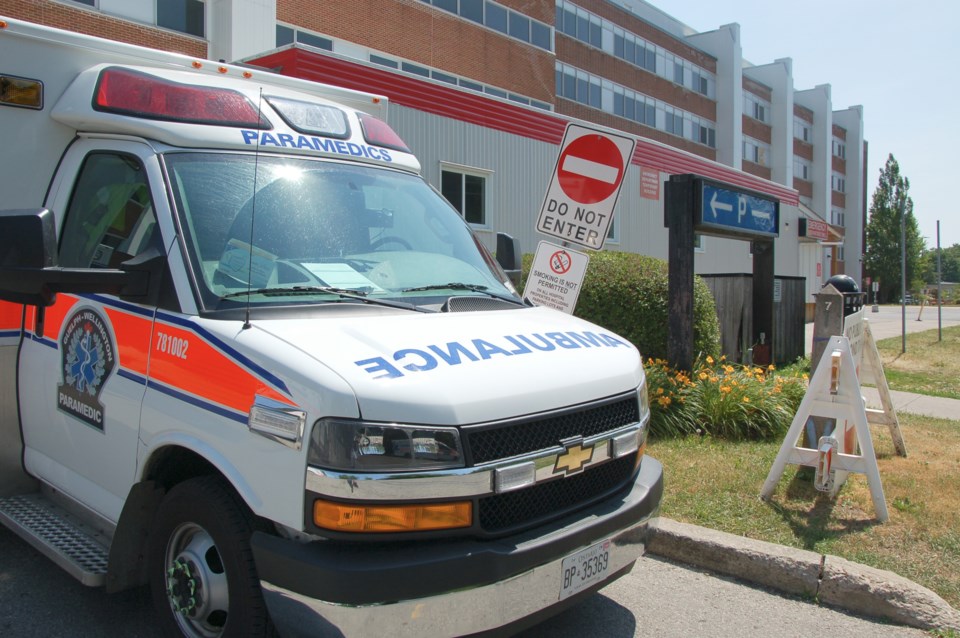In nearly every category of care, local paramedics failed to meet response time targets last year, a recently released report shows.
Guelph Wellington Paramedic Service (GWPS) fell particularly behind on the most urgent matters, such as heart attacks and sudden cardiac arrests. It only exceeded the targeted response time for the least urgent calls, which come with a 20-minute goal for things such as a sore throat.
“One of the challenges that hindered service delivery was the frequent and lengthy hospital offload delays experienced at Guelph General Hospital,” explains the report, explaining offload delays occur when hospital staff don’t assume a patient’s care within 30 minutes of arrival at the hospital.
“As a result, paramedics are required to stay at the hospital for an extended period to care for the patient,” the report continues. “In 2022, GWPS paramedics spent approximately 11,000 hours caring for patients who were in offload delay.”
The report is heading to city council's committee of the whole next week.
Response times are also impacted by the eight per cent increase in call volume compared to 2021, the report adds. There were more than 30,000 calls for service for the first time.
Efforts are underway to improve response times.
There are six categorizations of urgency for response times, each with its own targeted response time. The most urgent two are set by the Ministry of Health and Long-Term Care, with the others set by Guelph city council.
In the case of sudden cardiac arrests, which is a category unto itself, local paramedics met the six-minute response time target in 48 per cent of calls, which is below the set goal of 65 per cent of calls.
Similarly, GWPS was short of the target for calls in the severity categories level one through four.
The target for level one (resuscitation required) was to be on-scene within eight minutes for 65 per cent of calls. GWPS met that time goal in 63 per cent of cases.
Level two calls (major trauma) are to be responded to within 10 minutes, 75 per cent of the time. For GWPS, that was achieved in 71 per cent of cases.
There is a 15-minute response goal for level 3 calls (urgent care needed, such as shortness of breath) in 90 per cent of calls. Locally, that happened 88 per cent of the time.
The same targets apply to level four calls (less urgent care required, such as shortness of breath), which saw GWPS achieve it 83 per cent of the time.
Non-urgent, level five calls (a sore throat, for example), saw the 20-minute response time achieved 92 per cent of the time. The target was to achieve that response time in 90 per cent of calls.
“The purpose of setting response time targets is to provide the residents of our area with a reasonable expectation of ambulance response times in their community and to provide some accountability and transparency around the provision of the paramedic ambulance service,” says the report. “The service needs to attempt to arrive at all calls as quickly as possible because the severity of the patient’s condition, or their (call severity) level, cannot be verified before a paramedic arrives.”
Efforts to improve response times, as noted in the report, include a review of ambulance station locations throughout Guelph and Wellington County, as well as new triage software expected to help identify and focus on higher-priority calls.
That software is expected to be in place by the end of next year.
The province has also implemented a couple things aimed at helping, particularly with regard to offloading delays.
In an effort to reduce hospitalizations, the community paramedicine program offers non-emergency services to high-risk individuals in the community. Additionally, legislative changes now allow paramedics to take certain patients to receive medical care in places other than hospitals.
“Staff have been utilizing this opportunity,” the report states, referring to the latter. “This minor shift has resulted in a small but significant decrease in the number of patients presenting to the hospital, leading to better patient flow and fewer offload delays.”
